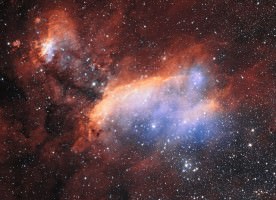Ever Wonder What the Difference is Between a Comet and a Meteor?

A comet is a small celestial object made mostly of ice and dust that, when close enough to the sun, displays a visible coma (a fuzzy outline) and sometimes a tail. They typically orbit the sun in elongated paths and can be visible for days. A meteor, also known as a shooting star or falling star, is the visible streak of light that occurs when a meteoroid (small piece of debris in space) enters the Earth’s atmosphere and vaporizes. Meteors are typically much smaller than comets and are only visible for a few seconds.
Read the rest of this entry >>Giant Bow Shock in Space
The beautiful image above shows a giant bow shock wave in space around a young star. The name of the star is LL Ori and it is located in one of our favorite locations in space – the Orion Nebula.
Snow Rollers – Rare Weather Phenomenon
Rare Snow Rollers formed throughout portions of Ohio and Pennsylvania during a particularly windy winter storm on January 27, 2014. Now I know that we normally post articles that are related to space and the universe, but this weather phenomenon is so rare I had to write about it! What makes it even better is that it happened right here at the world headquarters of Outer Space Universe. Snow Rollers very rarely form here. In fact, I’ve never seen them before!
Facts About Jupiter
I thought it was about time we talked about Jupiter. Jupiter is, after all, the biggest planet in our Solar System. In fact, it’s almost big enough to be a star! Let’s explore some facts about Jupiter.
New Stars Being Formed in the Prawn Nebula
Have you ever imagined what it would be like to witness new stars being formed? This image recently released by the European Southern Observatory, gives us a stunning new view of a stellar nursery. Named the Prawn Nebula or IC 4628, this immense region of space is loaded with all the ingredients needed to form new stars – and it’s happening right before our very eyes!





